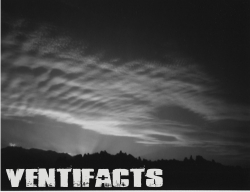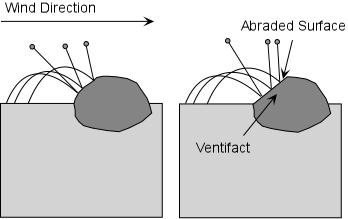Guincho; N38 43.706 W9 28.230
From the guidelines, as from January 2013"People do not need to wait for permission to log your EarthCache. Requiring someone to wait is not supported by the EarthCache guidelines. People should send their logging task answers to you, then log your EarthCache. When you review their logging task answers, if there is a problem, you should contact them to resolve it. If there is no problem, then their log simply stands."


Ventifacts are rocks that have been abraded, pitted, etched, grooved, or polished by wind-driven sand. These geomorphic features are most typically found in arid environments where there is little vegetation to interfere with aeolian particle transport, where there are frequently strong winds, and where there is a steady but not overwhelming supply of sand.
 Ventifacts can be abraded to eye-catching natural sculptures. In moderately tall, isolated rock outcrops, mushroom shaped pillars of rock may form as the outcrop is eroded by saltating sand grains. This occurs because, even in strong winds, sand grains can't be continuously held in the air. Instead, the particles bounce along the ground, rarely reaching no higher than 1 m above the ground. Over time, the bouncing sand grains can erode the lower portions of a ventifact, while leaving a larger less eroded cap. The results can be fantastic stone mushrooms. Otherwise, individual stones, such as those forming desert pavement, are often found with grooved, etched, or polished surfaces where these same wind driven processes have slowly worn away the rock.
Ventifacts can be abraded to eye-catching natural sculptures. In moderately tall, isolated rock outcrops, mushroom shaped pillars of rock may form as the outcrop is eroded by saltating sand grains. This occurs because, even in strong winds, sand grains can't be continuously held in the air. Instead, the particles bounce along the ground, rarely reaching no higher than 1 m above the ground. Over time, the bouncing sand grains can erode the lower portions of a ventifact, while leaving a larger less eroded cap. The results can be fantastic stone mushrooms. Otherwise, individual stones, such as those forming desert pavement, are often found with grooved, etched, or polished surfaces where these same wind driven processes have slowly worn away the rock.
When ancient ventifacts are preserved without being moved or disturbed, they may serve as a paleo-wind indicators. The wind direction at the time the ventifact formed will be parallel to grooves or striations cut in the rock.Source
In the Guincho area, particularly in the northern side of the dune field, the outcropping fossiliferous limestones are constantly being bombarded with sand particles due to the prevailing wind. As a result the rocks are striated due to the abrasive action of the wind driven sand particles. The coordinates given take you to a particular spot in this ventifact field but the field is much larger so feel free to wander about at will.

Go to ground zero and using the ventifacts as guides tell me which is the predominant wind direction in this zone and place a photo of you posing with a ventifact in your log (optional of course). E-mail the answer through my profile to validate the find.
Have fun!

A cache:
No local das coordenadas, observem os ventifactos e digam-me, baseado no desgaste dos afloramentos qual a direcção predominante do vento. Acrescentem uma foto vossa no campo de ventifactos (se quiserem) e têm um "found" assegurado.
Localização da cache da colega e geóloga Drª H. Santana.
Divirtam-se!
 The most exciting way to learn about the Earth and its processes is to get into the outdoors and experience it first-hand. Visiting an Earthcache is a great outdoor activity the whole family can enjoy. An Earthcache is a special place that people can visit to learn about a unique geoscience feature or aspect of our Earth. Earthcaches include a set of educational notes and the details about where to find the location (latitude and longitude). Visitors to Earthcaches can see how our planet has been shaped by geological processes, how we manage the resources and how scientists gather evidence to learn about the Earth. To find out more click HERE.
The most exciting way to learn about the Earth and its processes is to get into the outdoors and experience it first-hand. Visiting an Earthcache is a great outdoor activity the whole family can enjoy. An Earthcache is a special place that people can visit to learn about a unique geoscience feature or aspect of our Earth. Earthcaches include a set of educational notes and the details about where to find the location (latitude and longitude). Visitors to Earthcaches can see how our planet has been shaped by geological processes, how we manage the resources and how scientists gather evidence to learn about the Earth. To find out more click HERE.
